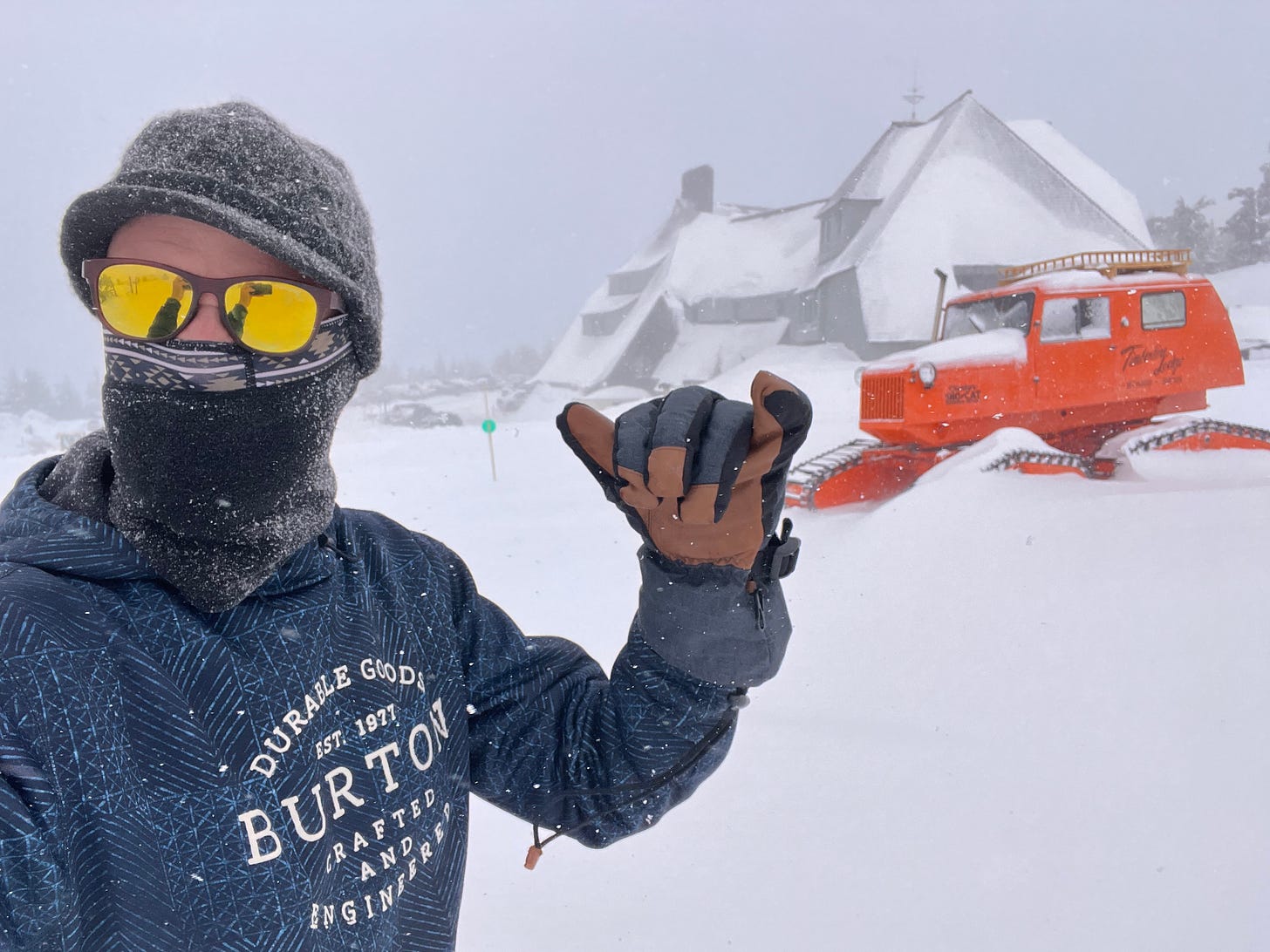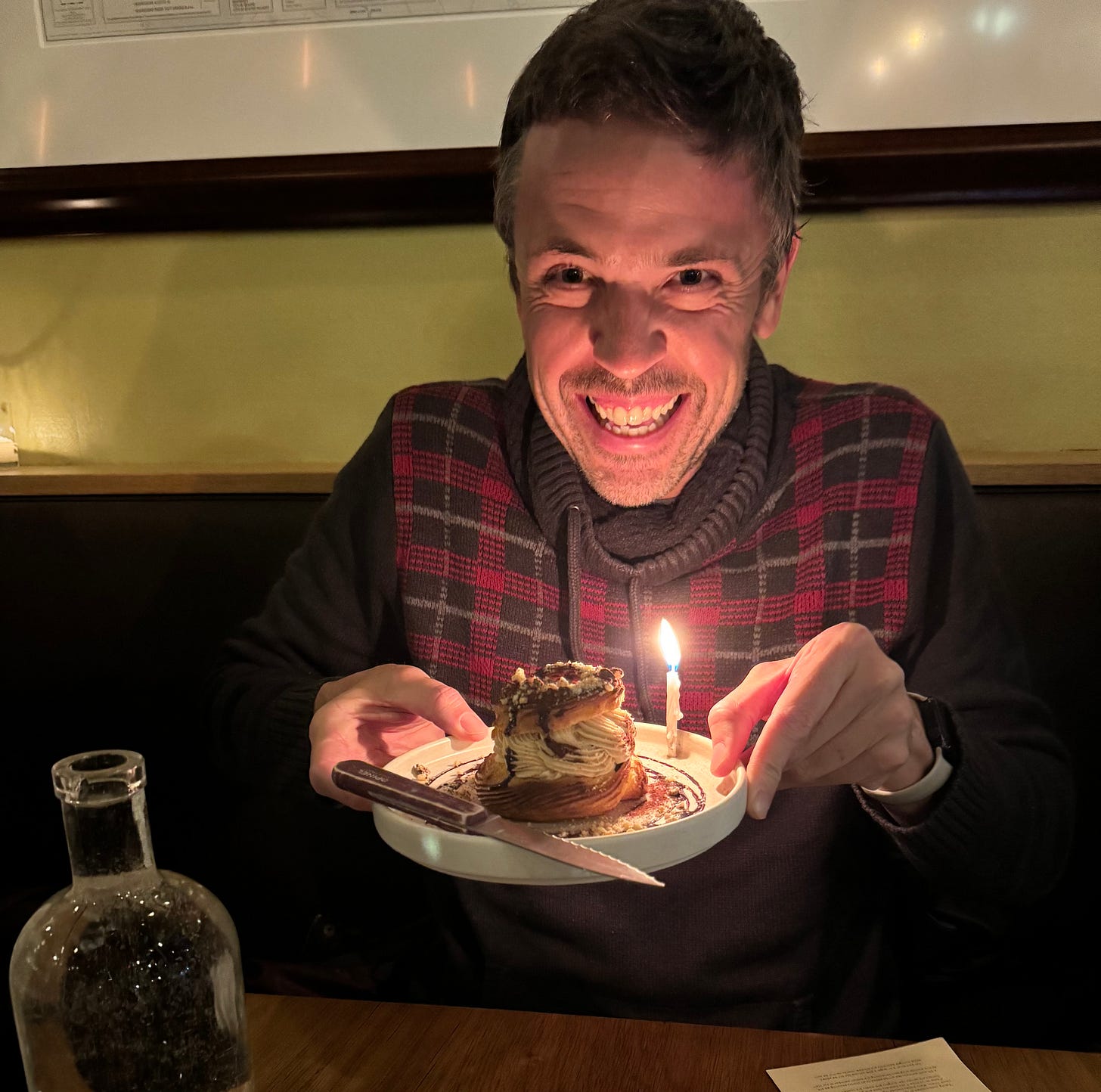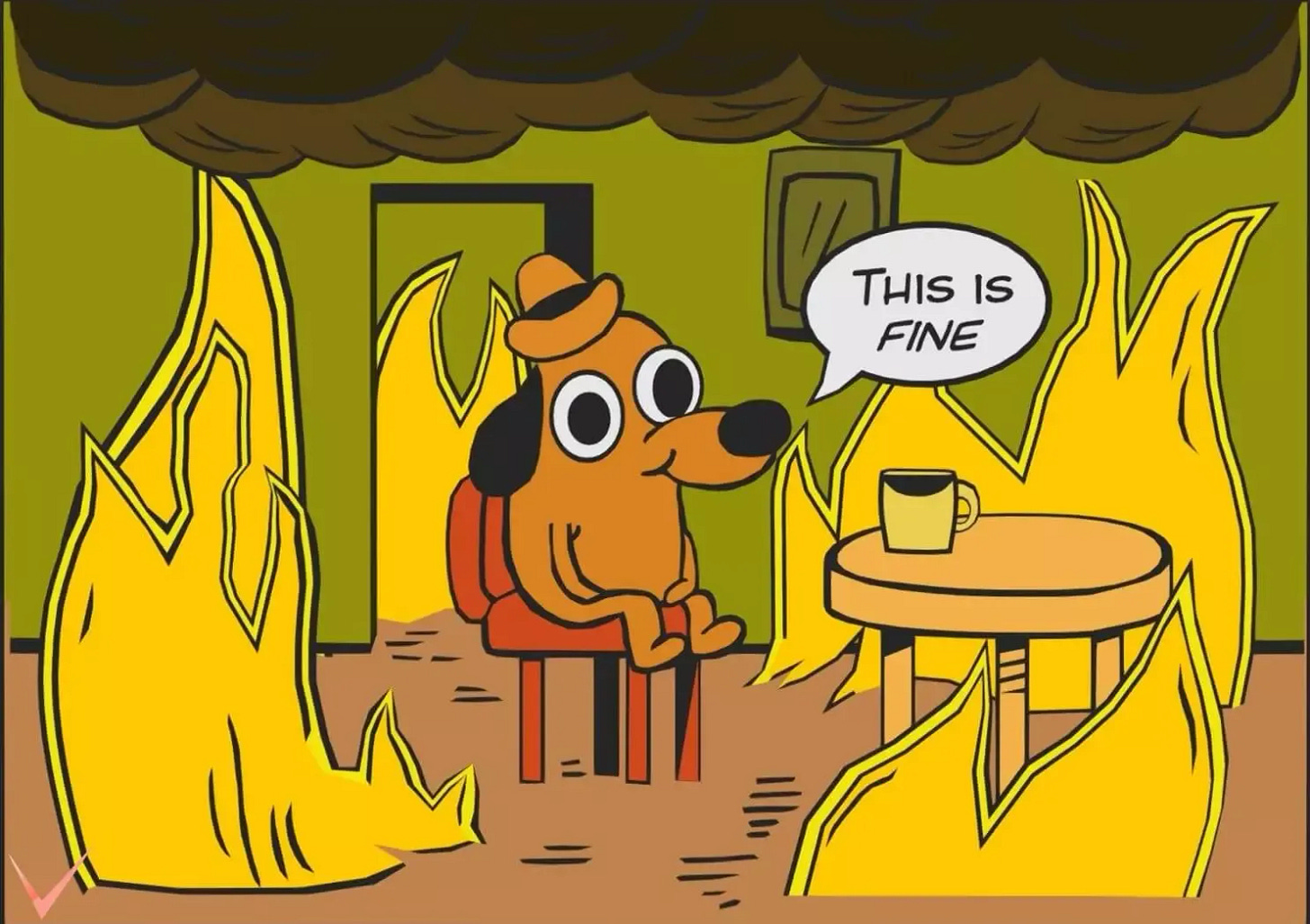What do we have to learn from winter?
The last few days of winter have come with some important learnings and reflections after a season of really leaning into the winter season.
In recent years I’ve become obsessed with learning about and leaning into the different seasons. This has especially been the case since moving to the Pacific Northwest, where we actually have distinct seasons, although we seemed to skip spring and went right into summer last year. There are a few reasons for this fascination with the seasons. One is my fascination with neature (can we get “neature” added to the Dictionary already), and the preparation, planning, resiliency, and growth that happens during the change of seasons for plants and animals.
We all know about Punxsutawney Phil and that groundhog’s important relationship with winter, but did you know that groundhogs are able to conserve energy and survive on stored fat for months? According to the National Wildlife Federation (NWF), groundhogs in the winter can slow their beats per minute from about 80 to 5 and slow their breaths per minute from 16 to as little as just a couple breaths. And then, almost immediately after waking up they get it on. What a life.
“Plants and animals don’t fight the winter; they don’t pretend it’s not happening and attempt to carry on living the same lives that they lived in the summer. They prepare. They adapt. They perform extraordinary acts of metamorphosis to get them through. Winter is a time of withdrawing from the world, maximising scant resources, carrying out acts of brutal efficiency and vanishing from sight; but that’s where the transformation occurs. Winter is not the death of the life cycle, but its crucible.” ― Katherine May, Wintering: The Power of Rest and Retreat in Difficult Times
Let’s talk about plants. Many plants store their own energy, too, often in form of sugar and other compounds, which act as an antifreeze during winter. WHAT?! According to a Penn State article, snowdrops, for example, actually need the cold for a process known as stratification in order to bloom. If that’s not some real Planet Earth shit.

My fascination and interest in the seasons, and particularly winter, extends to parts of the world that are more wintery in nature. Think Scandinavian and Nordic countries, where it is hella cold all winter long and dark basically all day. The town of Tromsø, for example, in Norway, doesn’t see the sun for nearly two months. Not as in it’s just cloudy and dreary every day, but rather it’s dark all day and night. Yet as many articles and studies cite, residents of Tromsø don’t see the depression that you might expect.
What’s more, Norway, and many other Nordic and Scandinavian countries top lists year in and year out about the happiest countries in the world. There have been a lot of articles about why this is, but among the top reasons are things like the combination of trust and social cohesion, equality, autonomy, and the quality of public services. There’s often more of an emphasis on spending time outdoors and tipping the work/life balance scales toward life. And then there’s that little thing called hygge, the cozy lifestyle that many countries like Norway and Holland seem to embody.
It should come as no surprise then that America is not near the top of these lists of the happiest countries.
“In our relentlessly busy contemporary world, we are forever trying to defer the onset of winter. We don’t ever dare to feel its full bite, and we don’t dare to show the way that it ravages us. An occasional sharp wintering would do us good. We must stop believing that these times in our lives are somehow silly, a failure of nerve, a lack of willpower. We must stop trying to ignore them or dispose of them. They are real, and they are asking something of us. We must learn to invite the winter in. We may never choose to winter, but we can choose how.”― Katherine May, Wintering: The Power of Rest and Retreat in Difficult Times
My increasing interest in learning about and leaning into the seasons, and especially winter, is in part based on my own experiences of it. For most of my adult life I’d just avoided winter altogether, by spending parts of winter in places like Mexico and Costa Rica, and living in Southern California for most of my 30s. My first real winter experience as an adult was in my early 30s, moving to Seattle in late fall. It kicked my ass, and I barely made it to summer before moving to Southern California.
When I returned to the Pacific Northwest, in early 2021, I was a different person, yet no less skeptical about wintering in the PNW. And my skepticism was met with back-to-back winters that yet again kicked my ass. Yet in hindsight, they were like invitations from the universe. I don’t feel like I’d ever properly accepted, let alone honored, what winter might have to bring or teach me. So like the more unsavory parts of my past, I’d just suppressed it.

But before I talk more about me, I can’t help but question how we approach winter culturally in the West, and especially in America. While the natural world is slowing down and cocooning, it would seem as if our culture does the opposite.
It’s as if there’s some life manual out there that we inherited, that’s like, “Chapter 1, “The Holidays…As it starts getting darker, colder, and the holidays get closer, you must therefore do more, spend more, and do it faster, or the holidays will be cancelled, and it’ll be Groundhog Day every day for eternity, and you will bring shame on your house, The End.” While groundhogs are slowing down their heart rate, it appears that we’re increasing ours.
If the holidays and end of the year wasn’t already burdensome enough, then there’s the pressure, shame, and guilt of everything we didn’t do over the last 12 months. Yay, Happy Holidays and Happy New Year! But quick, make a list of all the goals and resolutions that you won’t do and will feel shame about in another 12 months. And then it’s like award season just reminds us how little we did the previous year. Or is this just my commentary of culture?
So that really escalated quickly, I know. But I feel like that’s the pressure, weight, and gravity that we enter a season with that’s already so weighty as it is. The American Psychiatric Association in a 2022 poll found that 40% of Americans report an "overall decline in mood in the winter," with 66% reporting behavioral changes. An American Psychological Association poll found that 89% of those polled expressed stress around the holidays, with half of U.S. adults describing stress levels between November and January as "moderate."
Daily life and the weight of the world is stressful enough, and then we throw in holiday expectations, increased chances of getting sick, work pressure, family stress, inclement weather, et. al., and life is like an emotional pressure cooker.
When I was 13 years old, I was lucky enough to go to some of the events of the 1996 Summer Olympics, thanks to my sister, who lived in the heart of Atlanta. One of the events that she and her boyfriend (now husband) took me to was the track cycling event at Stone Mountain. Perched above this oval track, the velodrome, I watched with great interest and excitement as cyclists raced each other. (Stay with me here, I’m going somewhere with this.)
But this wasn’t your ordinary race. Being that it’s not even a few laps, you’d think that the strategy for success is to ride as fast as possible. Except it’s not. The first couple laps are slow—often painfully slow—as it becomes a bit of strategy, gamesmanship, and conserving energy. The last lap comes, and that’s when the sprinting happens. However, you actually want to be behind the lead cyclist, so that you can draft behind them and maintain speed while using less energy. I shit you not, the first 90 seconds of the following video is not in slow motion.
This recently took me down a rabbit hole, as I read about the science of endurance in long-distance cycling, and other sports, and how training “slower” is imperative for faster and better performance. There are a number of articles about the science behind endurance, like this Strava article, but in common terms, long and slow training is imperative for endurance athletes in how it helps their bodies become more adaptable and efficient. It's often referred to as Zone 2, or "base training."
As orthopedic surgeon Dr. Howard J. Luks writes, “Zone 2 heart rate training, by improving mitochondrial flexibility, enables you to use fat as an energy source for longer and more efficiently.” As Luks continues, “Thus, you preserve your glycogen (glucose) stores for longer.”
This all takes me back to Punxsutawney Phil and all the plants and animals which use their fat and nutrient stores to help them adapt and survive winter. Circle of life y’all!
“Doing those deeply unfashionable things—slowing down, letting your spare time expand, getting enough sleep, resting—is a radical act now, but it is essential. This is a crossroads we all know, a moment when you need to shed a skin. If you do, you’ll expose all those painful nerve endings and feel so raw that you’ll need to take care of yourself for a while. If you don’t, then that skin will harden around you.”
― Katherine May, Wintering: The Power of Rest and Retreat in Difficult Times
Toward the beginning of this, I mentioned the Norwegian town of Tromsø, which doesn’t see the sun for nearly two months in the winter. Does anyone else get depressed just thinking about that? However, what was most fascinating wasn’t that they don’t see the depression rates that you may expect. What shocked me was that according to one study, by May Trude Johnsen at the University of Tromsø, there were no “significant seasonal differences in mental distress” across seasons.
If you’ve been to Scandinavia during the summer, then you know that the days are LONG, and that it’s absolutely stunning, and Tromsø is no exception. And so it was altogether surprising, encouraging, and heart-warming to learn about that. One integral component of this, as The Guardian wrote, appears to be the mindset of Tromsø residents and how they approach winter. As health psychologist, Kari Leibowitz, and many others have found, mindset can have a huge impact on both our mood and physiological responses. To pull from the words of Zach Galifianakis in Due Date, we have to check ourselves before we wreck ourselves.

This winter I was resolved to approach it differently; to not just survive winter, but thrive in it. As I thought about how nature approached and adapted with winter, I thought how I might could adapt with it. The beginning of winter brought with it some new approaches and intentions, like joining a book club reading Clarissa Pinkola Estés’ Women Who Run With the Wolves. In Estés story of the Skeleton Woman, I became obsessed with this concept of the life/death/life cycle, and how I could apply that to winter. As Estés writes:
“Sometimes the one who is running from the Life/Death/Life nature insists on thinking of love as a boon only. Yet love in its fullest form is a series of deaths and rebirths. We let go of one phase, one aspect of love, and enter another. Passion dies and is brought back. Pain is chased away and surfaces another time. To love means to embrace and at the same time to withstand many endings, and many many beginnings- all in the same relationship.”
I feel like this winter brought with it some figurative deaths, while it invited a slowness and quietness that I don’t think I’ve experienced to this extent in winter (save for 2020-2021). I continued to not drink alcohol, went off social media for all of winter, and cut back on eating out and ordering takeout, and instead cooked more at home. I also finally seem to have mastered the power nap. In fact this week I took a 20-minute nap at home on MONDAY, in the middle of a full day of work. I know, I don’t know who I am either.
This winter saw me double down on connection, which has arguably been the most important word for me over the last year. In addition to therapy, I attended group therapy-ish processing calls a couple times per week. I got lunch most Fridays with one of my closest childhood friends. I played pick-up basketball on a number of Wednesday nights. I developed a workout plan. I continued my journaling practice. I had more phone conversations with friends. And I was lucky enough to have a number of birthday celebrations with family and friends in February.
There were days that completely stretched me. I remember one day in particular, in which I used every single one of the tools I had, but still felt overwhelmed, anxious, and dysregulated. A January ice storm particularly kicked my ass, and I think just about everyone’s ass in Portland. And past thought and behavior patterns crept in. Yet all of that is ok, and it is a part of being a human. I’ll take it.
One of the hardest, yet most powerful and important lessons of these last couple winters is how much of an invitation it’s been to really be with my feelings. Winters of old I would spend traveling, busying myself, and largely avoiding the gravity and feelings that would often accompany winter. After all, this was what was modeled to me as a child—to just escape conflict and that which was difficult, uncomfortable, or overwhelming.
This winter was like this juxtaposition of resolve, surrender, and intentionality. And I feel like past winters, and this last 20 months of self-excavation, really helped me prepare for it. I recently came across this Henry David Thoreau quote, which I thought nailed my sentiment.
"'Hear! hear!' screamed the jay from a neighboring tree, where I had heard a tittering for some time, 'winter has a concentrated and nutty kernel, if you know where to look for it.'"

Flowers are starting to bloom, cherry blossoms are starting to pop, birds are doing a musical outside my window right now, the days are longer, and this weekend may see the first 70-degree days of the year in the PNW. As it feels like earth is waking up from a season of hibernation, quiet, and slowing down, so it feels like I am. On paper, it doesn’t feel like I did much. But it was arguably the most restful, connected, cup-filling, bittersweet, meaningful, growing winters I’ve had. I am so damn grateful.
Already, in these last few days of winter and what I’m calling the first few unofficial days of spring, there’s a certain pop, aliveness, rising energy, and progress I’ve felt. Perhaps it’s timing, perhaps it’s the universe universing, or perhaps it’s the byproduct of a very intentional, restful, reflective winter. Whatever it is, I’m here for it.
This isn’t one of those articles that’s like, do these 7 things and you too can have a meaningful, restful winter. I write this in part as a signpost for myself, as a testament of the power of honoring the seasons and living with intention. I don’t think about winter as soul murder, even if there have been a couple winters that felt like it. It’s an invitation. And sometimes that invitation brings grief, death, and the shutting of doors that brings life, connection, and open doors elsewhere.
Though I admit, too, that I’m in part channeling
’s words from Wintering. I’ve quoted her a few times here, and I can’t recommend her book enough. It’s like a warm, hyggy blanket, and one I’ll come back to winter after winter.Here is another truth about wintering: you’ll find wisdom in your winter, and once it’s over, it’s your responsibility to pass it on. And in return, it’s our responsibility to listen to those who have wintered before us. It’s an exchange of gifts in which nobody loses out. — Katherine May, Wintering: The Power of Rest and Retreat in Difficult Times


